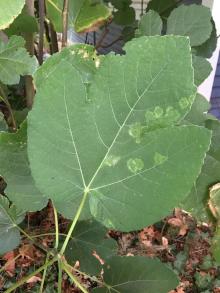By H. M. Rivedal
Cause The fig mosaic virus (FMV) is a single-stranded RNA virus that is transmitted by the eriophyid mite, Aceria ficus. FMV can also be transmitted by vegetative propagation and grafting but not by seed. Mites can overwinter in buds on fig trees. The disease has been observed in both Oregon and Washington and is common on the central California coast.
Complicating the issue is that there are 11 other viruses and three viroids associated with the symptoms. It is not clear if they are somehow associated with the disease, synergistic with FMV or just coincidentally found in these diseased plants.
Symptoms Leaves throughout the tree have light-green-to-yellow mosaic patterns that turn to brown or black necrotic leaf lesions as the season progresses. Leaves can become distorted. Fruit can also show mosaic patterns, which can lead to a decrease in yield due to the premature dropping of fruit. Mosaic symptoms can be exacerbated by high temperatures in the summer.
Cultural control Using clean (symptom free) planting materials and controlling mites is most effective in reducing disease.
- Remove and destroy any diseased plants.
- Cutting out buds in winter can help reduce mite numbers.
- Promote good fig tree nutrition.
References Ashihara, W., Kondo, A., Shibao, M., Tanaka, H., Hiehata, K., and Izumi, K. 2004. Ecology and control of eriophyid mites injurious to fruit trees in Japan. JARQ 38(1): 31-41.
Preising, S., Borges, D. F., de Queiroz Ambrósio, M. M. and da Silva, W. L., 2021. A fig deal: a global look at fig mosaic disease and its putative associates. Plant Disease, 105:727-738.



